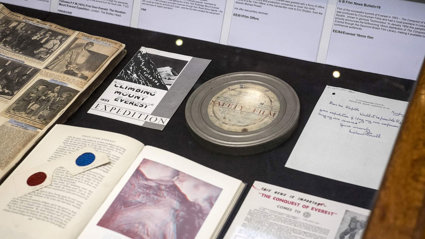
Research by Jan Faull.
September 2013 start (part-time), 2019 completion. Royal Holloway, University of London: PI Professor Felix Driver.
Overview
The project investigated the production, distribution and presentation of films made on successive Everest expeditions between 1922 and 1953.
Drawing on unique archival film collections held by the British Film Institute, the Everest expedition archives and related collections such as The Times archives, the research considers the logistical and technical requirements of expeditionary film, including the role of Sherpa porters in film-making; the role of media sponsorship in shaping the presentation of expedition work; and how film was shown, and to what audiences, within the context of popular and scientific understandings of mountaineering in the period.
The research also considers the wider significance and potential uses of the Everest film archive. This involves consideration of the role of key organisations, including the Society and the BFI, in developing a community of interest around geographical film in the first half of the twentieth century.
What is the project about?
This project considered the significant role of the moving image in recording the expeditions to climb Mount Everest 1922-1953.
It examined the history and technical development of the medium during the first half of the twentieth century with particular reference to the engagement of the Mount Everest Committee, representing the Royal Geographical Society and the Alpine Club, with the commissioning and exhibition of cinematographic records of the successive expeditions.
How is it underpinned by the Society’s collections? How are you using those materials?
The Society’s collections contain unique original paper records of the planning, contractual obligations and the undertaking of each of the Everest expeditions.
Media negotiations, newspaper cuttings albums and private correspondence were used alongside published reports, papers and memoirs to evaluate the role of film. The recent acquisition of the Sandra Noel Archive provided a new and valuable insight into the pioneering role of the cinematographer Captain John Noel who filmed the expeditions in 1922 and 1924.
The records enabled study of audience outcomes and the continued use of film records to provide historical content for both commercial distribution and educational instruction.
During the period of study the Society’s Film Collection was digitised, enabling full access online.
How is the work important and what does it shed light on?
The study has considered a hitherto little researched aspect of the Everest expeditions – the role of the film records held as part of the Society’s collections. Films taken between 1922 and 1953 provide examples of both commercially produced and non-professionally filmed material. Previously only available in analogue form for study at the BFI National Archive, the analogue material has now been digitised and made accessible.
The project has revealed new insights into the role of media culture in promoting and managing exhibition. It has also highlighted the crucial role of archival preservation and restoration.
This has enabled a re-evaluation of the place of film within the historiography of successive attempts to climb Everest and its development as a means of disseminating geographical and scientific knowledge.
Find out more
A printed copy of this thesis is avaialable for consultation in the Foyle Reading Room (reference only). An electronic copy (PDF) can be accessed through the University of Royal Holloway University of London Research Portal.
Useful references
- Anon. (1923) ‘The Mount Everest Kinematograph Film’. Geographical Journal 61, No.1.
- Anon. (1925) ‘The Mount Everest Film of 1924’. Geographical Journal 65. No.1.
- Davis, W. (2011) Into the Silence: The Great War, Mallory and the Conquest of Everest. London: Bodley Head.
- Gordon, R. J., Brown, A. K. and Bell, J. A. (eds.) (2013) Recreating First Contact: Expeditions, Anthropology, and Popular Culture. Washington: Smithsonian Institution.
- Hansen, P. H. (1996) ‘The Dancing Lamas of Everest: Cinema, Orientalism and Anglo-Tibetan Relations in the 1920s’, American Historical Review 101, 712-747.
- Hansen, P. H. (2001) ‘Coronation Everest: The Empire and Commonwealth in the Second Elizabethan Age’, in Ward, S. (ed.) British Culture and the End of Empire. Manchester: Manchester University Press, 57-72.
- Isserman, M. and Weaver, S. (2008) Fallen Giants: A History of Himalayan Mountaineering from the Age of Empire to the Age of Extremes. New Haven: Yale University Press.
- Low, R. (1979) The History of the British Film 1929-1939: Films of Comment and Persuasion of the 1930s. London: Allen & Unwin.
- Noel, S. (2003) Everest Pioneer: The Photography of Captain John Noel. Stroud: Sutton.
- Peterson, J. L. (2013) Education in the School of Dreams: Travelogues and Early Nonfiction Film. London: Duke.
- Ruoff, J. (ed.) (2006) Virtual Voyages: Cinema and Travel. Durham: Duke University Press.
Key collections and sources
- Our Collection: Mount Everest Committee Archives
- Our Collection: Royal Geographical Society Archives – Correspondence Blocks/ Council Minutes
- Our film collection available to view on player.bfi.org.uk
- British Film Institute: BFI National Archive/ Special Collections and Reuben Library
- British Library: India Office Records
- Times Newspapers Ltd. Archive
Additional resources
- Geographical Journal – the unbound printed copies in the Foyle Reading Room contain adverts placed by sponsors supporting Everest expeditions. These provide useful background information on film equipment, clothing, food supplies etc.
- The Correspondence Blocks in our Collections archives are a useful source to contextualise material found in the Mount Everest Committee Archive.
- The Society’s Photographic Collection, including lantern slides, fully complements the films themselves.
Key films from our Collections
- Climbing Mount Everest (1922)
- The Epic of Everest (1924)
- Climbing Mount Everest (1933)
- Wings Over Everest (1934)
- The Conquest of Everest (1953)